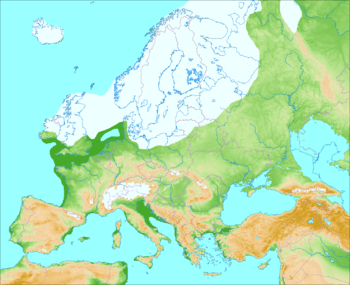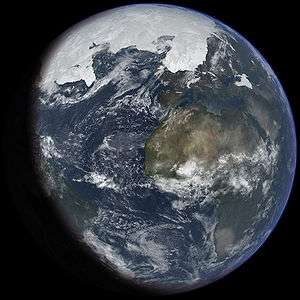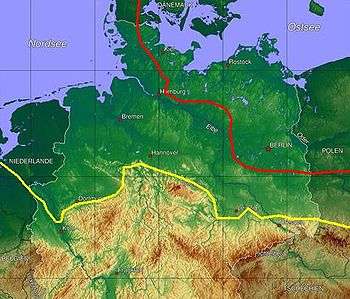Weichselian glaciation

The last glacial period and its associated glaciation is known in Northern Europe as the Weichselian glaciation, Weichselian ice age (German: Weichsel-Eiszeit), Vistulian glaciation, Weichsel[1] or, less commonly, the Weichsel glaciation, Weichselian cold period (Weichsel-Kaltzeit), Weichselian glacial (Weichsel-Glazial), Weichselian Stage or, rarely, the Weichselian complex (Weichsel-Komplex). In the Alpine region it corresponds to the Würm glaciation. It was characterised by a large ice sheet that spread out from the Scandinavian Mountains and extended as far as the east coast of Schleswig-Holstein, the March of Brandenburg and North Russia.
In Northern Europe it was the youngest of the glacials of the Pleistocene ice age. The preceding warm period in this region was the Eemian interglacial. The last cold period began about 115,000 years ago and ended 11,700 years ago.[2] Its end corresponds with the end of the Pleistocene epoch and start of the Holocene.
| Evolution of the Baltic Sea |
|---|
| Pleistocene |
|
Eemian Sea (130,000–115,000 BP) Ice sheets and seas (115,000–12,600 BP) |
| Holocene |
|
Baltic Ice Lake (12,600–10,300 BP) Yoldia Sea (10,300–9,500 BP) Ancylus Lake (9,500–8,000 BP) Mastogloia Sea (8,000–7,500 BP) Littorina Sea (7,500–4,000 BP) Modern Baltic Sea (4,000 BP–present) |
Naming in other parts of the world
In other regions the glaciations of the last glacial period are given other names: for example that in the Alpine region is called the Würm glaciation, in the British Isles it is the Devensian glaciation and in North America, the Wisconsin glaciation.[3][4]
Sequence and subdivisions of the Weichselian

About 115,000 years ago[2] average temperatures dropped markedly and warmth-loving woodland species were displaced. This significant turning point in average temperatures marked the end of the Eemian interglacial and start of the Weichselian glacial stage. It is divided into three sections, based on the temperature variation: the Weichselian Early Glacial,[5][6] the Weichselian High Glacial[5] (also Weichselian Pleniglacial[6]) and the Weichselian Late Glacial.[6] During the Weichselian, there were frequent major variations in climate in the northern hemisphere, the so-called Dansgaard-Oeschger events.
The Weichsel Early Glacial (115,000 - 60,000 BC) is in turn divided into four stages:
- Odderade Interstadial (WF IV). The pollen spectra indicate a boreal forest. It starts with a tree birch phase, which rapidly transitions to pine forest. Also apparent are larches and spruce as well as low numbers of alder.
- Rederstall Stadial (also WF III). In North Germany the pollen spectra indicate a grassy tundra followed later by shrubby tundra.
- the Brörup Interstadial (also WF II). Several profiles show a short period of cooling shortly after the start of the Brörup Interstadial, but this does not appear in all profiles. This led some authors to distinguish the first warm period as the Amersfoort Interstadial. However, since then, this first warm period and cooling phase has been included in the Brörup Interstadial. Northern Central Europe was populated by birch and pine woods. The Brörup Interstadial is identified with marine isotope stage 5c.
- the Herning Stadial (also called WF I) was the first cold phase, in which northwestern Europe was largely treeless. It corresponds to marine isotope stage 5d.
In the Weichselian High Glacial (57,000 - c. 15,000 BC) the ice sheet advanced into North Germany. In this period, however, several interstadials have been documented.
- Glaciation and ice sheet advances to North Germany (Brandenburg Phase, Frankfurt Phase, Pomeranian Phase, Mecklenburg Phase).
- Denekamp Interstadial. The pollen spectra indicates a shrubby tundra landscape.
- Hengelo Interstadial. The pollen show sedges (Cyperaceae) and temporarily a high number of dwarf birches (Betula nana).
- Moershoofd Interstadial. The pollen spectra show a treeless tundra vegetation with a high proportion of sedges (Cyperaceae).
- Glinde Interstadial (WP IV). The pollen diagrams indicate a treeless, shrubby tundra.
- Ebersdorf Stadial (WP III). In North Germany this period is characterised by pollen-free sands.
- Oerel Interstadial (WP II). The pollen diagrams point to a treeless, shrubby tundra in North Germany.
- Schalkholz Stadial (WP I). The first ice advance may have already reached the southern Baltic Sea coast. At the type lokality of Schalkholz (county of Dithmarschen) pollen-free, sands indicate a largely vegetation-free landscape.
The short "Weichselian Late Glacial" (12,500 - c. 10,000 BC) was the period of slow warming after the Weichselian High Glacial. It was however again interrupted by some colder episodes.
- Younger Dryas. In this period the proportion of non-tree pollens climbed again, especially those of heliophytes.
- Allerød oscillation. This section is again dominated by birch tree pollens
- Older Dryas. This cool period is characterised by a reduction in tree pollens
- Bølling oscillation. The period begins with a rapid increase in tree birch pollens.
- Oldest Dryas. The cool period is characterised by a maximum number of non-tree pollens
- Meiendorf Interstadial. This interstadial is typified by a rise in the pollens of dwarf birches (Betula nana), willows (Salix sp.), sandthorns (Hippophae), junipers (Juniperus) and Artemisia.
Following the last of these cold periods, the Younger Dryas, the Weichselian Glacial ended with an abrupt climb in temperature around 9,660 ± 40 BC.[7] This was the start of our present interglacial, the Holocene.
In addition to the above subdivisions the depositions of the Weichselian Late Glacial following the retreat of the ice sheet are divided into four stages: the Germanic Glacial (Germaniglazial) (Germany becomes ice-free), the Danish Glacial (Daniglazial) (Denmark becomes ice-free), The Gotland Glacial (Gotiglazial) (Gotland becomes ice-free) and the Finnish Glacial (Finiglazial) (Finland and Norway become ice-free).[8]

See also
References
- ↑ Whittow, John (1984). Dictionary of Physical Geography. London: Penguin, 1984, p. 580. ISBN 0-14-051094-X.
- 1 2 Litt et al. (2007: pp.45ff)
- ↑ F.J. Monkhouse Principles of Physical Geography, London: University of London Press, 1970 (7th edn.), p. 254. SBN 340 09022 7
- ↑ Whittow, John (1984). Dictionary of Physical Geography. London: Penguin, 1984, p. 265. ISBN 0-14-051094-X.
- 1 2 Wolfgang Schirmer, Quaternary field trips in central Europe, Volume 1, Pfeil, 1995, p. 375. ISBN 978-39-238-7191-9
- 1 2 3 John Dodson (ed.), Earth Systems and Society, New York, London, etc., Springer, 2010 p. 173. ISBN 978-90-481-8716-4
- ↑ Friedrich M, Kromer B, Spurk M, Hofmann J, Kaiser KF.(1999): Paleo-environment and radiocarbon calibration as derived from Late Glacial/Early Holocene tree-ring chronologies. In: Quaternary International 61:27–39.
- ↑ Karl N. Thome (1998), Einführung in das Quartär. Das Zeitalter der Gletscher (in German), Berlin: Springer-Verlag, pp. 72
Literature
- Thomas Litt; Karl-Ernst Behre; Klaus-Dieter Meyer; Hans-Jürgen Stephan; Stefan Wansa (2007), T. Litt im Auftrag der Deutschen Stratigraphischen Kommission, ed., "Stratigraphische Begriffe für das Quartär des norddeutschen Vereisungsgebietes", Stratigraphie von Deutschland - Quartär. Special issue. Eiszeitalter und Gegenwart/Quaternary Science Journal (in German), Stuttgart: E. Schweizerbart’sche Verlagsbuchhandlung (Nägele und Obermiller), 56, No. 1/2, pp. 7–65, doi:10.3285/eg.56.1-2.02 (inactive 2016-10-21), ISSN 0424-7116
- H. Liedtke & J. Marcinek: Physische Geographie Deutschlands, Justus Perthes Verlag, Gotha, 1995 ISBN 3-623-00840-0